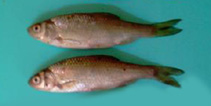| Family: |
Leuciscidae (Minnows), subfamily: Leuciscinae |
| Max. size: |
23.3 cm TL (male/unsexed) |
| Environment: |
benthopelagic; freshwater |
| Distribution: |
Europe: lakes and mostly still water of rivers of the Adriatic drainages, from Croatia to Montenegro and Albania. |
| Diagnosis: |
Dorsal soft rays (total): 11-11; Anal soft rays: 11-11. Leucos basak is distinguished from other congeners by the following characters: moderate size, usually 12.0-14.0 cm SL; lack of a mid-lateral band; body uniformly silvery in life; peritoneal membrane black; usually 36-38 pored scales on lateral line (vs. 38-43 in the other congeners). It differs from Leucos aula by the absence of lateral band and black peritoneal membrane (vs. silvery in L. aula); from L. panosi and L. ylikiensis mainly by having usually 9-10 gill rakes (vs. 18-20 in L. ylikiensis and 13-14 in L. panosi). Leucos basak is most closely related to L. albus based on molecular analyses but differs from this species by having 36-38 scales on lateral line (vs. usually 41-42 in L. albus); 9 branched dorsal rays (vs. 8 in L. albus); and blackish peritoneal membrane (vs. nearly silvery in L. albus) (Ref. 96829). |
| Biology: |
Occurs in a wide range of habitats such as warm streams and rivers with moderate to slow current, lakes, backwaters, swampy areas, and artificial water bodies (Ref. 59043). Sympatric with Leucos albus in Lake Skadar (Ref. 96829). Feeds on plankton and plant material. Spawns over gravel and stones and in flooded areas and lakes. Eggs are sticky, yellow-orange which hatch in 9 days at 13-17°C (Ref. 59043). |
| IUCN Red List Status: |
Least Concern (LC); Date assessed: 31 January 2006 Ref. (130435)
|
| Threat to humans: |
harmless |
Source and more info: www.fishbase.org. For personal, classroom, and other internal use only. Not for publication.
